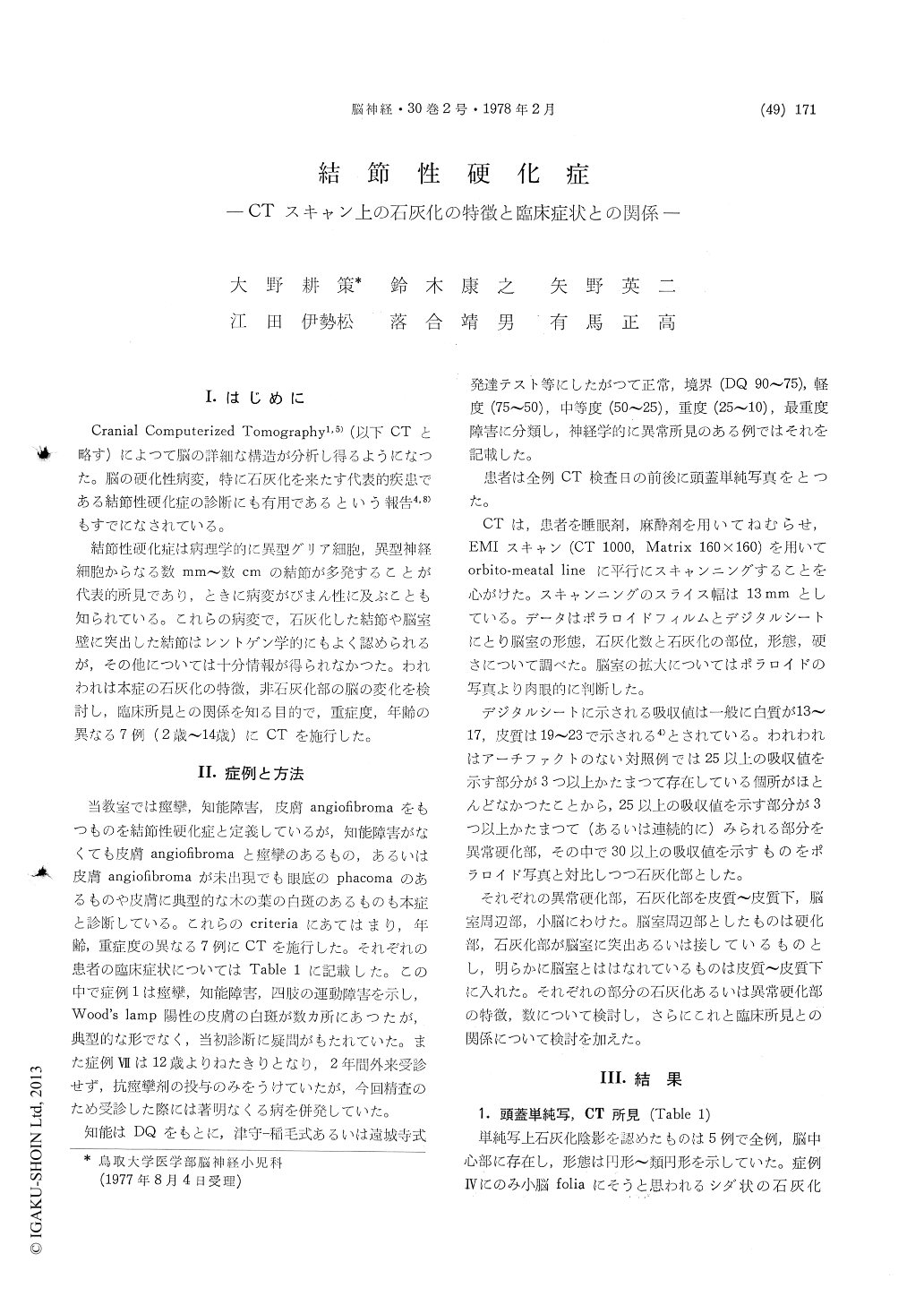Japanese
English
- 有料閲覧
- Abstract 文献概要
- 1ページ目 Look Inside
I.はじめに
Cranial Computerized Tomography1,5)(以下CTと略す)によつて脳の詳細な構造が分析し得るようになつた。脳の硬化性病変,特に石灰化を来たす代表的疾患である結節性硬化症の診断にも有用であるという報告4,8)もすでになされている。
結節性硬化症は病理学的に異型グリア細胞,異型神経細胞からなる数mm〜数cmの結節が多発することが代表的所見であり,ときに病変がびまん性に及ぶことも知られている。これらの病変で,石灰化した結節や脳室壁に突出した結節はレントゲン学的にもよく認められるが,その他については十分情報が得られなかつた。われわれは本症の石灰化の特徴,非石灰化部の脳の変化を検討し,臨床所見との関係を知る目的で,重症度,年齢の異なる7例(2歳〜14歳)にCTを施行した。
The brain of patients with tuberous sclerosis is characterized by multiple sclerotic nodules and calcifications. Severity of the neurological symptoms and mental states are varied from case to case. In order to investigate the relationship between the anatomical changes of the brain and the severity of the disease. Cranial computerized tomography (EMI scan) was performed on 7 children with tuberous sclerosis aged 2 to 14 years old. The absorption coefficients from computer print-out and polaroid films were analyzed. A high density area showing 30 or more absorption coefficient was regarded as calcification, and a less dense area showing 25 to 29 was regarded as the sclerotic area. The mental grade of patients was normal in one, border line in one, debility in one, imbecilityin one, severe imbecility in one and idiocy in two cases. Infantile spasms were observed in 4, Lennox syndrome in one, grandmal in one and focal moter seizure in one case. Neurological dysfunction such as spasticity or hypotonus was observed in 3 cases.
Results was as follow ;
1) Calcifications of various sizes were found in 6 cases, and they located mainly in the periven-tricular area. Cortical or subcortical calcified areas were found in 3 cases. Periventricular calcified areas were clearly defined from surround tissue, but the border of cortical and subcortical calci-fications tend to be obscure. Cerebellar calcification, which was shown as fern-like calcification by plain skull X-ray film, was found in one case.
2) Nodular sclerotic area in the cortical or sub-cortical areas was found in 3 cases. Diffuse cortical sclerosis was found in a severly retarded case aged 2 years old.
3) Ventricular dilatation was found in 4 cases. Partial block of the cerebrospinal fluid was suspected in 2 cases ; one showed right ventricular dilatation and another showed marked dilatation of the third and lateral ventricles. In these cases, however, nodules blocking the foramen of Monro or aqueduct could not be detected on CT. Moderate ventricular dilatation in the other two cases was probably due to diffuse cerebral atrophy or dysgenesis.
4) The absorption coefficients of periventricular calcifications tended to increase with advancing the age. The number of calcifications was not corelate with the age of the patients.
5) In severely affected cases, ventricular dila-tation and cortical or subcortical calcifications were frequently seen, but a case of the normal intelli-gence also had cortical or subcortical calcifications. Corelation between the localization of calcifications and neurological dysfunctions, such as mental de-ficiency, paresis or convulsions, could not been obtained.

Copyright © 1978, Igaku-Shoin Ltd. All rights reserved.


